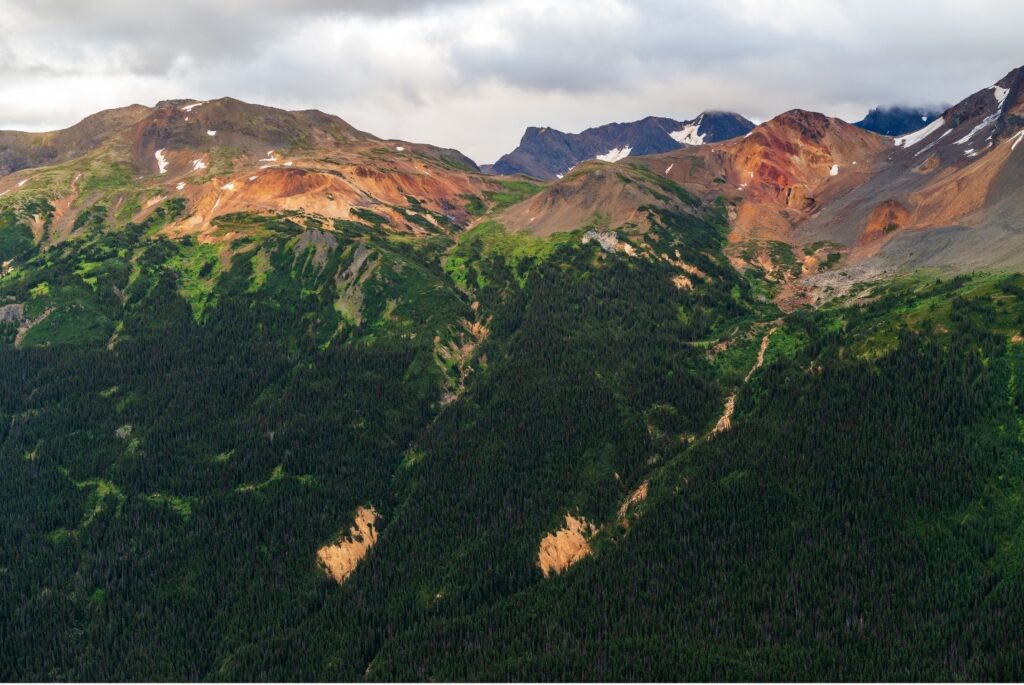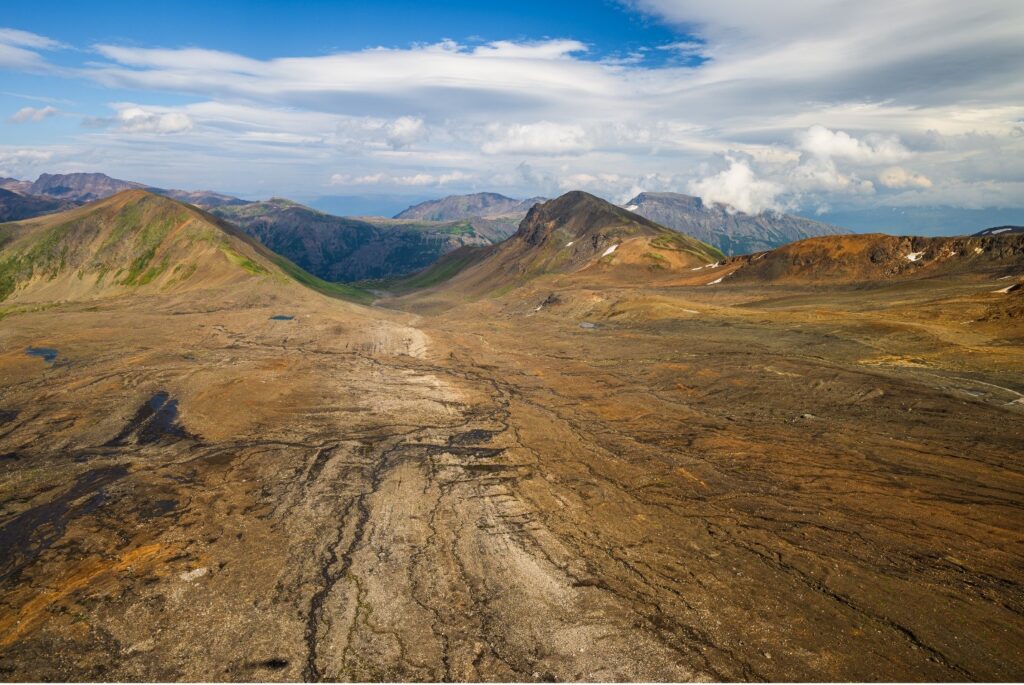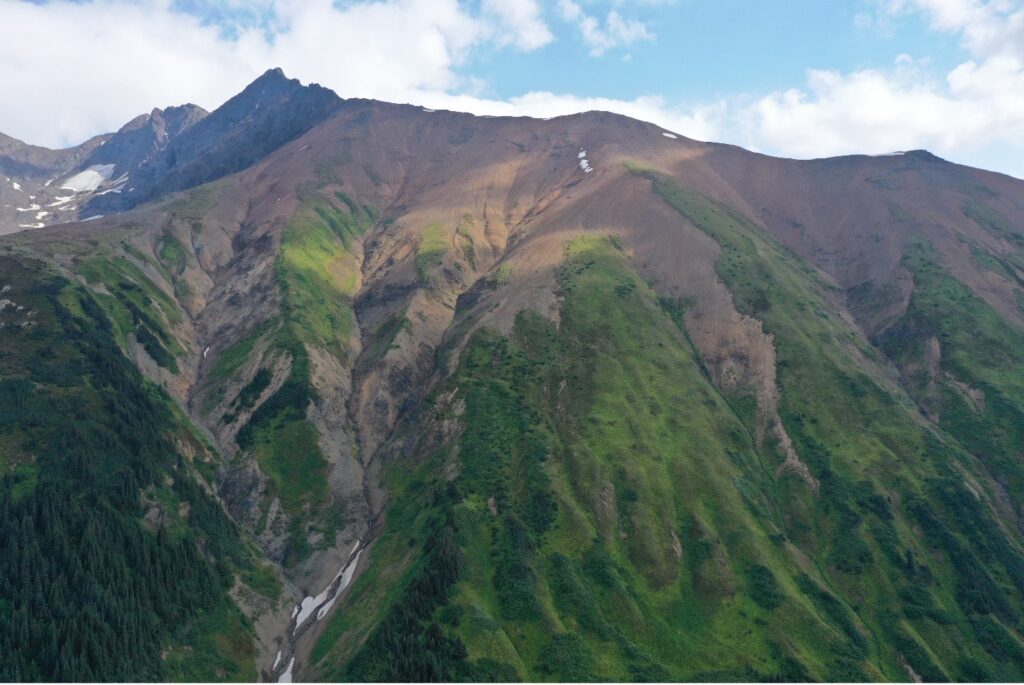VANCOUVER, British Columbia, September 10, 2024 – Kingfisher Metals Corp. (TSX-V: KFR) (FSE: 970) (OTCQB: KGFMF) (“Kingfisher” or the “Company”) is pleased to report the completion of its program of mapping, sampling, and IP surveys at the consolidated HWY 37 and LGM projects in the Golden Triangle, British Columbia.
Highlights
- IP surveys were completed at the Mary-ME porphyry, and Hank-Williams porphyry-epithermal areas totalling 14.14 line km.
- Mapping was completed at the Mary, ME, Hank, Williams, Rainbow, Ridge, Goat and Grizzly targets in addition to several unnamed areas of interest.
- The addition of porphyry-epithermal expert Dr. Stephanie Sykora to the technical advisory board.
- Historical drill core from the Mary, Rainbow, Hank, and Williams zones was reviewed.
- The planned ZTEM survey was delayed due to equipment issues and weather delays at other projects and is expected to begin at the HWY 37 project this week.
- Machine learning with VRIFY AI is currently underway and results will be released once 2024 data is integrated into the exploration model.
- The BC Geological Survey spent a week on site as part of a porphyry research initiative that will include future age dates.
Dustin Perry, CEO states “After spending a week on site this year visiting all of the porphyry-epithermal centers on the project, I am even more encouraged by the tremendous discovery potential of this large land position in the prolific Golden Triangle, Additionally, after working with Stephanie the last two field seasons we are thrilled to have her join our advisory board. Her wealth of global experience in copper-gold systems will be a significant asset as we advance our projects in the Golden Triangle.”
Dr. Stephanie Sykora, states “After two field seasons working with Kingfisher on their HWY 37 project, I am encouraged to see the potential in their large land package, which shows various styles of mineralization in prospective terrain that hasn’t yet been fully explored. It is exciting to be part of the progress with a dynamic, young team that is discovery driven.”
Dr. Stephanie Sykora is a seasoned exploration geologist with over a decade of global experience working with major and junior companies. She has a PhD degree in Geology from the University of Tasmania (CODES), Australia where she studied the giant Lihir (Ladolam) alkalic epithermal gold deposit in Papua New Guinea, under supervision of Professor David Cooke and Dr. David Selley.
Dr. Sykora currently works as an independent consultant, and via OreQuest Consultants Ltd., with various companies in Canada, USA, Mexico and worldwide. She has held positions at First Quantum Minerals in South America, Australia, and globally for generative porphyry copper exploration, and at Teck Resources in BC, Canada in porphyry exploration at Highland Valley Copper. Her expertise includes field mapping, technical evaluations, project generation, structural geology, and porphyry-epithermal systems. Dr Sykora has published several articles in peer-reviewed scientific journals as well as various scientific communications for earth sciences.
HWY 37 Project and LGM Project Summary
The contiguous HWY 37 and LGM projects cover 630 km2 within the prolific Golden Triangle and are host to porphyry, epithermal, and VMS mineralization spanning from the Late Triassic to Middle Jurassic.
The Grizzly Cu-Au porphyry system is inferred to be the oldest at the project (Late Triassic). Previous workers identified pseudoleucite-bearing volcanic host rocks, a unique rock type also present at the world class, alkalic Galore Creek deposit (Teck/Newmont) located 50 km to the west. Historical trenching at Grizzly returned 0.74% Cu and 1.09 g/t Au over 38 m.
Texas Creek intrusions (Early Jurassic) are the most widespread at the projects with a span over 25 km in a NE to SW trend with widespread geochemical anomalies and alteration. Mary, Williams, Rainbow, and Hank alteration systems are all related to these intrusions which also drive mineralization at the Sulphurets District (KSM, Treaty Creek, and Brucejack) and the Snip-Iskut District. The Company notes that mineralization on nearby projects or metal districts is not indicative of mineralization on the HWY 37 or LGM Projects.

Figure 1: Regional Overview Map – HWY 37 and LGM Projects
2024 Exploration Program
The 2024 field program was designed to refine drill targets across the HWY 37 and LGM projects. A focus was placed on new interpretations of the controls on mineralization across a broad area through detailed geological mapping by Dr. Stephanie Sykora. A total of 214 rock samples were taken by Kingfisher geologists, 296 geological field stations collected, and 14.14 line km of IP surveys were surveyed over 4 lines (Figure 2).
The BC Geological Survey spent 7 days studying intrusions across the project area as part of a regional porphyry research initiative. Results from the 2024 exploration program will be released once they are received and interpreted.
The ZTEM survey which was planned for earlier in the summer has been delayed due to equipment and weather issues at other nearby projects. Despite this, the survey is planned to begin this week.

Figure 2: 2024 Exploration Program
Hank-Williams Trend
Mapping at the Hank-Williams Trend focused on improving the understanding of the structural controls to mineralization in areas prospective for drilling. Surface mapping also identified an expanded extent of hydrothermal alteration of roughly 6 x 6 km of quartz-sericite-pyrite (QSP).
Two IP lines were completed to extend coverage to the south and north of historical surveys. The southwestern line (3.2 km) is designed to test below an area concealed by young (post-gold) rocks and to characterize the Rojo Grande target. The northeastern line (5.7 km) spans the known Williams porphyry deposit, across the Hank epithermal deposit, and southeast past the limit of historical drilling for over 2.5 km. This line is designed to outline porphyry targets below the known Hank epithermal system, to generate a fingerprint of the Williams deposit on the same line.

Figure 3: The Hank Deposit within the Hank-Williams Trend
Mary Trend
One 3.2 km IP line is designed to outline the trend of mineralization at an optimal azimuth not completed on previous surveys and provide information to drill target the Mary Root Zone and the deeper extents of the Mary deposit. The line will also include the DM porphyry to the northeast, which returned 0.28 g/t Au and 0.21% Cu over 223.3 m from 16 m depth (BC-06-03) and the Cliff porphyry to the southwest, which was drill tested with two holes in 2023 with the best intercept returning 0.11% Cu over 114 m (M-23-001).
Mapping and sampling in the area outlined a ~600 m-long zone of stockwork and sheeted veins that parallels the overall northeast to southwest trend of mineralization to the south and west of the DM Zone that has only been partially tested with historical drilling. One outcrop of chalcopyrite-bearing stockwork north of the DM zone was also visited and sampled that has not been tested by drilling. Kingfisher geologists noted bornite in historical drill core in the DM area which indicates potential for elevated relative copper for exploration targets. Bornite has not yet been identified in drill extents at the higher elevation, known Mary deposit.

Figure 4: The Mary Deposit
ME
Mapping was completed at the ME porphyry target to the south of the Mary deposit and Cliff porphyry. Two areas of porphyry stockwork were mapped, chip-channel sampling was completed, and one 2-km IP line was completed with the goal of outlining the geometry of chargeable mineralization identified on surface. Widespread ‘quartz-sericite-pyrite’ alteration was noted across the zone with significant chalcopyrite mineralization hosted within stockwork over a ~300 m of vertical extent.

Figure 5: The ME Zone
Rainbow
The Rainbow Zone occurs as a small outcrop with brecciated vein clasts of high-level sheeted porphyry veins. Mapping in 2024 noted that the breccia occurs with a magnetite (potassic) matrix. Previous operators drilled below the discovery hole (RN-11-01; 0.76 g/t Au over 91 m) with limited success.
The brecciated and structurally complex nature of mineralization in the area of historical drilling provides a geological explanation for how previous operators did not reproduce the initial drill results. Drill core review confirmed this field observation. Given the presence of potassic alteration at surface associated with gold and limited surface exposures due to the presence of widespread glacial till, future exploration in 2025 should include IP surveys in addition to ground based magnetic surveys which should outline areas of magnetite-cemented breccias.

Figure 6: The Rainbow Zone
Ridge
The Ridge Zone hosts widespread in-soil and stream sediment geochemical anomalies for Au-Ag and base metals. Two days of mapping were completed at the Ridge Zone. Mapping indicated the presence of widespread carbonate alteration similar to other targets on the project (e.g., Mary and Hank) and is potentially indicative of a high-level porphyry environment. Mapping focused on vein and pyrite densities across two drainages. Future work will be planned after interpreting ZTEM results.

Figure 7: The Ridge Zone
Grizzly
The Grizzly Zone lies in the southwestern region of the recently acquired LGM Project. Grizzly is host to copper-gold porphyry mineralization with historical trench sampling of 0.74% Cu and 1.09 g/t Au over 38 m. The Company spent one day mapping creek exposures in the vicinity of historical sampling. Preliminary mapping and 3D modeling indicate that the limited amount of historical drilling failed to cross the trend of mineralization.

Figure 8: The Grizzly Zone
BC Geological Survey
The BC Geological Survey (BSGS) completed 7 days of fieldwork at the HWY 37 and LGM projects which consisted of sampling outcrop and drill core for the various intrusive suites associated with mineralization. They are completing a large-scale study north of the Iskut river that includes other significant projects such as Galore Creek. Their study will include obtaining dates from a number of these samples as well as characterizing the nature of these prospective intrusions with whole rock geochemistry and petrography. The Company wishes to thank the BCGS for their helpful insight, as well as the additional ground we were able to cover during this program. Additionally, the Company looks forward to receiving accurate U-Pb age dates from their work which will further help characterize and drill target the mineralization on the projects.
Qualified Person
Dustin Perry, P.Geo., Kingfisher’s CEO, is the Company’s Qualified Person as defined by National Instrument 43-101, Standards of Disclosure for Mineral Projects, and has prepared the technical information presented in this release.
Kingfisher Metals Corp. (https://kingfishermetals.com/) is a Canadian based exploration company focused on underexplored district-scale projects in British Columbia, including the Golden Triangle region. Kingfisher has two 100% owned district-scale projects and an option to earn 100% of the HWY 37 Project, that offer potential exposure to gold, copper, silver, and zinc. The Company currently has 43,201,553 shares outstanding.
For further information, please contact:
Dustin Perry, P.Geo.
CEO and Director
Phone: +1 236 358 0054
E-Mail: info@kingfishermetals.com
Neither the TSX-V nor its Regulation Services Provider (as that term is defined in the policies of the TSX-V) accepts responsibility for the adequacy or accuracy of this release.
Cautionary Note Regarding Forward-Looking Statements
Mineralization hosted on adjacent and/or nearby properties is not necessarily indicative of mineralization hosted on the Company’s property. This news release contains statements that constitute “forward-looking statements.” Such forward-looking statements involve known and unknown risks, uncertainties and other factors that may cause the Company’s actual results, performance or achievements, or developments to differ materially from the anticipated results, performance or achievements expressed or implied by such forward-looking statements. Forward-looking statements are statements that are not historical facts and are generally, but not always, identified by the words “expects,” “plans,” “anticipates,” “believes,” “intends,” “estimates,” “projects,” “potential” and similar expressions, or that events or conditions “will,” “would,” “may,” “could” or “should” occur.
The forward-looking information contained in this news release represents the expectations of the Company as of the date of this news release and, accordingly, is subject to change after such date. Readers should not place undue importance on forward-looking information and should not rely upon this information as of any other date. The Company undertakes no obligation to update these forward-looking statements in the event that management’s beliefs, estimates or opinions, or other factors, should change.
